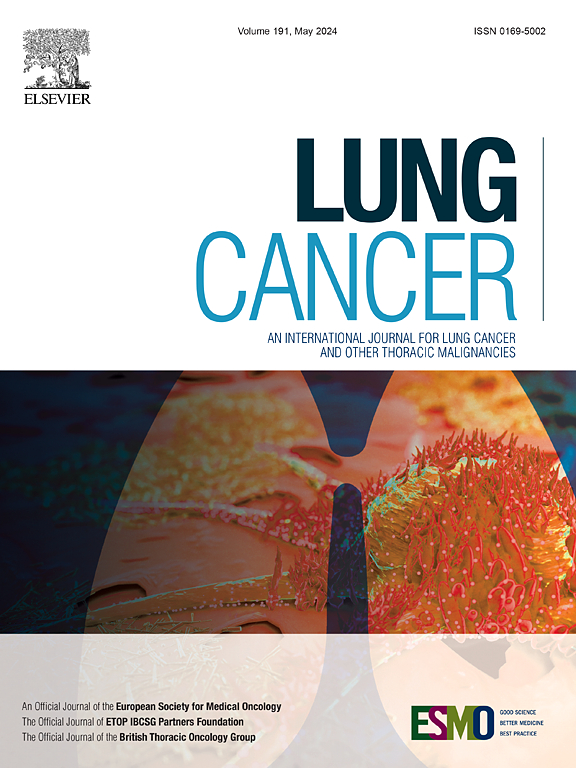第9版TNM分级中N2亚型和分期迁移对手术切除肺癌预后的影响
IF 4.5
2区 医学
Q1 ONCOLOGY
引用次数: 0
摘要
目的:在第九版肺癌TNM分级中,将N2细分为单站(N2a)和多站受累(N2b),并将部分分期改为II-III期。本研究旨在验证新分类,并确定分期转移和分期转移对各病理分期预后的影响。材料和方法:共纳入1754例手术切除的肺癌患者。比较各新病理N (pN)状态患者的临床特征。根据新的pN状态和病理分期评估总生存期(OS)。结果:pN2a患者的OS优于pN2b患者,但无统计学意义(p = 0.083)。在pN2a和pN2b之间,包括临床N状态在内的一些患者特征没有显著差异。低分期患者(从IIB到IIA的T1N1M0、从IIIA到IIB的T1N2aM0、从IIIB到IIIA的T3N2aM0)的OS与其他同分期患者的OS差异无统计学意义(p = 0.376、p = 0.630、p = 0.970)。抢期患者(IIIA至IIIB阶段的T3N2bM0)的OS明显优于其他同期患者(p)。结论:虽然N2亚分对生存分层有一定影响,但术前pN2细分情况难以预测。由于阶段迁移的复杂影响,第三阶段的OS差异在第九版中比在第八版中小,反之亦然。本文章由计算机程序翻译,如有差异,请以英文原文为准。
Prognostic impact of the N2 subclassification and stage migration in the ninth edition of the TNM classification in surgically resected lung cancer
Objectives
In the ninth edition of the TNM classification of lung cancer, N2 is subdivided into single-station (N2a) and multiple-station involvement (N2b), and some stage changes are made to stage II–III. This study aimed to validate the new classification and determine the effect of stage migration and vice versa on the prognosis of each pathological stage due to these changes.
Materials and Methods
A total of 1,754 patients with surgically resected lung cancer were included. Clinical characteristics of patients at each new pathological N (pN) status were compared. Overall survival (OS) was evaluated according to the new pN status and pathological stages.
Results
The OS of pN2a patients tended to be superior to that of pN2b patients without significance (p = 0.083). Several patient characteristics, including clinical N status, were not significantly different between pN2a and pN2b. The OS of the downstaged patients (T1N1M0 from IIB to IIA, T1N2aM0 from IIIA to IIB, and T3N2aM0 from IIIB to IIIA) was not significantly different from that of other patients in the same stages (p = 0.376, p = 0.630, and p = 0.970, respectively). The OS of the upstaged patients (T3N2bM0 from IIIA to IIIB) was significantly better than that of other patients in the same stage (p < 0.001). The 5-year OS rates of stages IIIA and IIIB were 63.3 % and 49.4 % in the eighth edition and 58.9 % and 54.3 % in the ninth edition, respectively.
Conclusion
Although the N2 subclassification had some impact on survival stratification, it was difficult to predict the subdivided pN2 status, preoperatively. The OS difference in stage III was smaller in the ninth edition than in the eighth edition, due to the complex effects of stage migration and vice versa.
求助全文
通过发布文献求助,成功后即可免费获取论文全文。
去求助
来源期刊

Lung Cancer
医学-呼吸系统
CiteScore
9.40
自引率
3.80%
发文量
407
审稿时长
25 days
期刊介绍:
Lung Cancer is an international publication covering the clinical, translational and basic science of malignancies of the lung and chest region.Original research articles, early reports, review articles, editorials and correspondence covering the prevention, epidemiology and etiology, basic biology, pathology, clinical assessment, surgery, chemotherapy, radiotherapy, combined treatment modalities, other treatment modalities and outcomes of lung cancer are welcome.
 求助内容:
求助内容: 应助结果提醒方式:
应助结果提醒方式:


